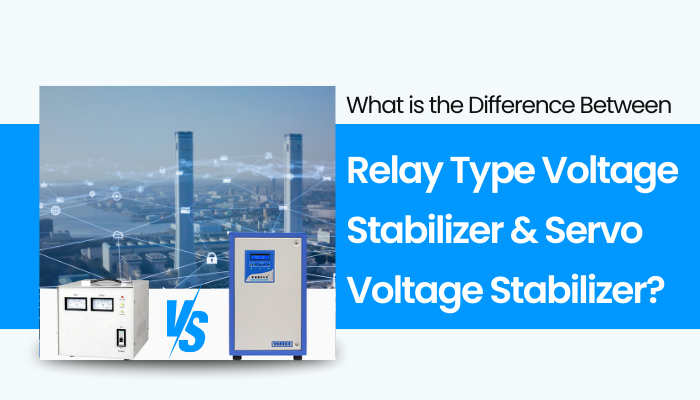Voltage stabilizers play a crucial role in ensuring stable power supply, protecting electrical appliances from voltage fluctuations, and improving energy efficiency.
In India, industries, commercial buildings, and homes often experience unstable voltage, which can damage sensitive electrical equipment. To prevent such issues, two types of stabilizers are commonly used: Relay Type Voltage Stabilizer and Servo Voltage Stabilizer.
When searching for stabilizer manufacturers in Chennai, it is essential to understand the key differences between these two stabilizers to choose the best option based on your requirements. In this article, we will compare Relay Type and Servo Voltage Stabilizers, their working principles, advantages, and ideal applications.
Understanding Relay Type Voltage Stabilizer
1. Working Principle
A Relay Type Voltage Stabilizer regulates voltage by switching electromechanical relays to control the output voltage. When the input voltage fluctuates, the stabilizer automatically selects a relay to adjust the output voltage to the required level.
2. Key Features
- Operates using relays for voltage regulation.
- Typically provides 5V to 10V step voltage corrections.
- Designed for low and medium-power applications.
- Commonly used for home appliances, such as TVs and refrigerators.
- Affordable and lightweight, but with slower correction speed.
3. Advantages of Relay Type Stabilizers
✅ Low Cost – Cheaper than servo stabilizers, making them suitable for household use.
✅ Compact Design – Small in size and easy to install.
✅ Easy Maintenance – Requires minimal servicing.
4. Limitations of Relay Type Stabilizers
❌ Slower Response Time – Takes more time to correct voltage fluctuations, usually in milliseconds.
❌ Limited Voltage Regulation Accuracy – Typically maintains ±10% voltage correction, which is not suitable for high-precision equipment.
❌ Not Ideal for Heavy Loads – Cannot handle high KVA loads, making it unsuitable for industrial applications.
Understanding Servo Voltage Stabilizer
A Servo Voltage Stabilizer is a more advanced and efficient voltage correction system that ensures precise and stable output voltage. It is widely used in industries, commercial buildings, and IT sectors where high accuracy and quick response are required.
If you are looking for servo stabilizer manufacturers in Chennai, investing in a high-quality servo stabilizer can significantly improve the efficiency and lifespan of electrical equipment.
1. Working Principle
A servo stabilizer uses a servo motor-controlled mechanism to adjust voltage levels smoothly and efficiently. Unlike relay stabilizers, it continuously monitors the input voltage and makes fine adjustments using a buck-boost transformer to provide an accurate ±1% voltage output regulation.
2. Key Features
- Uses servo motors and buck-boost transformers for precise voltage control.
- Provides ±1% voltage regulation accuracy.
- Fast correction speed of 50V–60V per second.
- Handles high-capacity loads from 5 KVA to 500 KVA.
- Ideal for industrial machines, medical equipment, and IT infrastructure.
3. Advantages of Servo Voltage Stabilizers
✅ High Voltage Accuracy – Delivers precise voltage correction with ±1% accuracy.
✅ Fast Response Time – Corrects voltage fluctuations in real-time, ensuring stable power supply.
✅ Handles Heavy Loads – Suitable for industries, hospitals, and data centers.
✅ Longer Equipment Lifespan – Protects costly machinery and electronics from voltage-related damage.
4. Limitations of Servo Voltage Stabilizers
❌ Higher Initial Cost – More expensive than relay stabilizers.
❌ Requires Regular Maintenance – Needs periodic servicing for long-term efficiency.
Relay vs. Servo Voltage Stabilizers: A Detailed Comparison
Feature | Relay Type Voltage Stabilizer | Servo Voltage Stabilizer |
Technology | Uses relays for step voltage correction | Uses servo motors for smooth voltage correction |
Voltage Accuracy | ±10% | ±1% |
Correction Speed | Slow | Fast (50V–60V per second) |
Application | Home appliances | Industrial & commercial use |
Load Handling | Limited (up to 5 KVA) | High capacity (5 KVA – 500 KVA) |
Lifespan | Shorter | Longer |
Cost | Affordable | Higher initial investment |
Which Stabilizer Should You Choose?
When selecting a stabilizer, it is essential to consider factors such as power requirement (KVA), accuracy, and response time. If you are looking for servo stabilizer manufacturers in India, ensure that they offer high-quality, energy-efficient solutions tailored to your specific needs.
- For Home & Small Offices → Relay type stabilizers are a budget-friendly choice.
- For Commercial & Industrial Applications → Servo voltage stabilizers are ideal due to their superior performance and energy efficiency.
Conclusion: Why Servo Voltage Stabilizers Are a Better Investment?
While relay-type stabilizers are affordable, servo voltage stabilizers provide better accuracy, faster response time, and improved power efficiency. For industries, hospitals, and commercial buildings, investing in a high-quality servo stabilizer ensures long-term savings and protects valuable equipment.
If you are searching for servo voltage stabilizer suppliers, look for reliable manufacturers who offer:
✅ Customized solutions based on power load and voltage conditions
✅ High-efficiency stabilizers with advanced protection features
✅ Comprehensive warranty and after-sales support
For businesses and industries, a servo stabilizer is a smart investment that guarantees power stability and efficiency, reducing energy consumption and maintenance costs over time.


